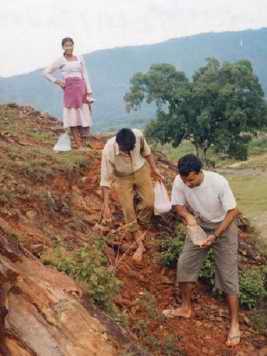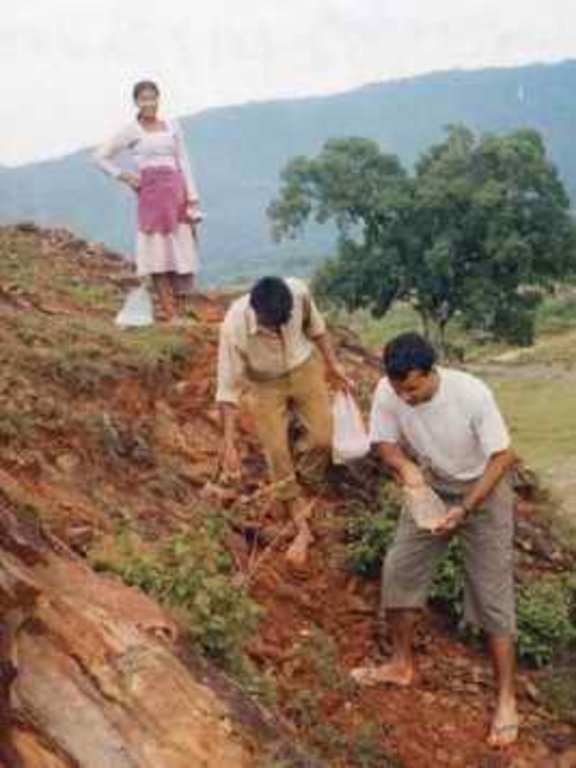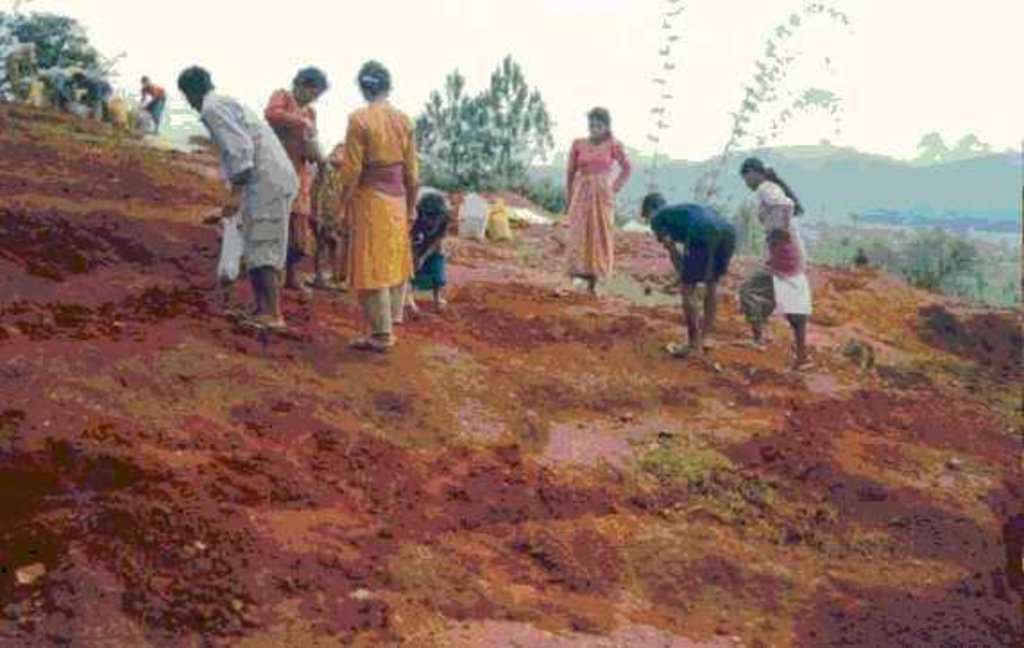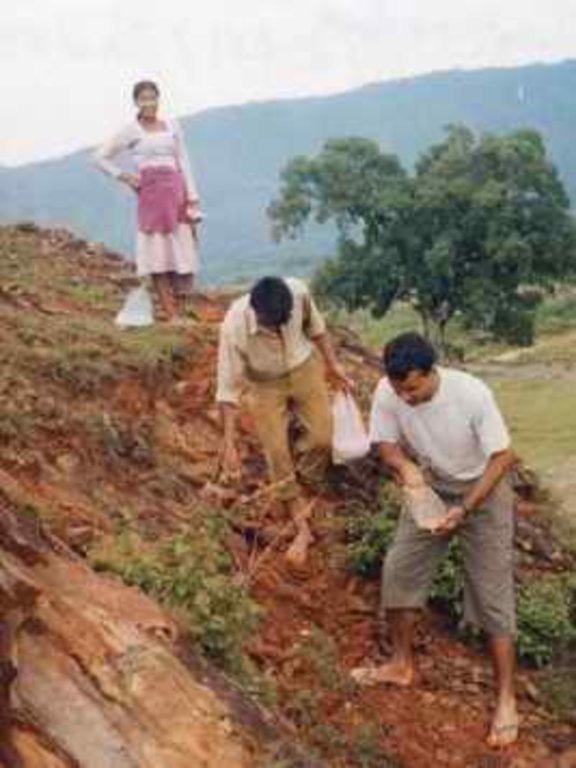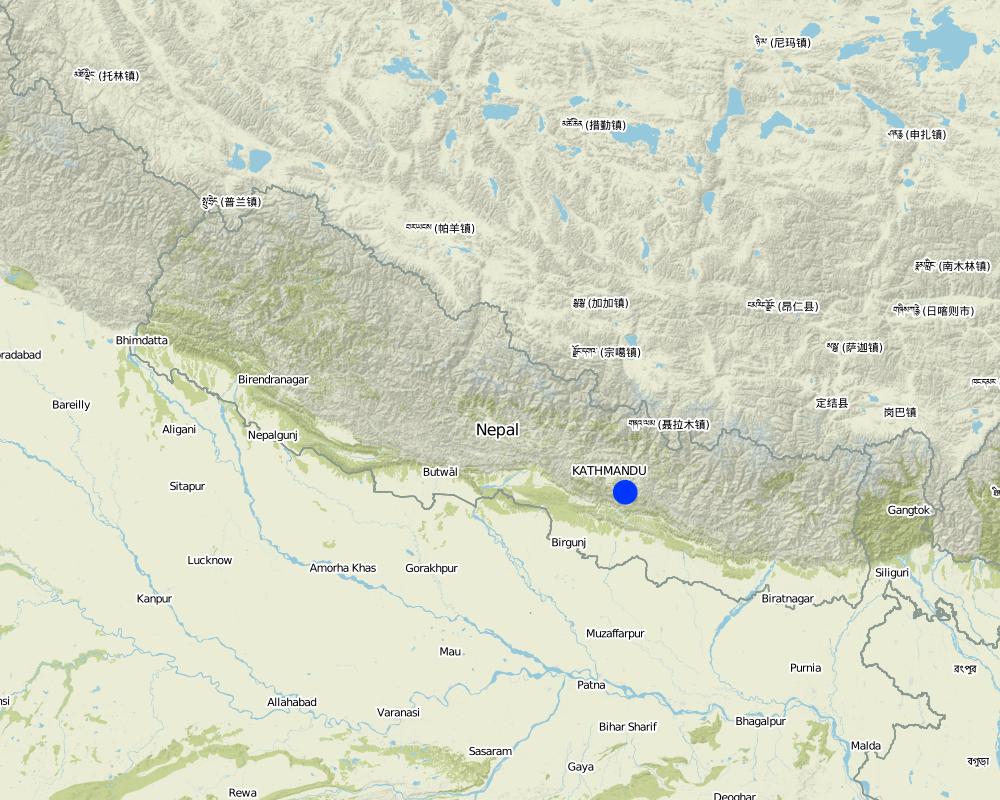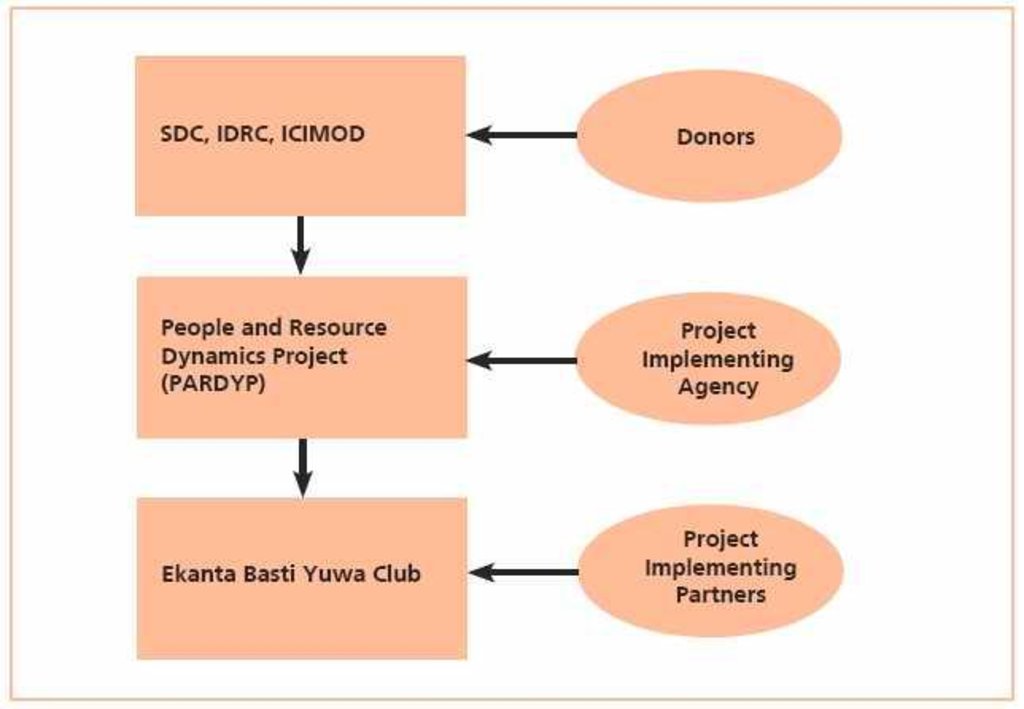Local initiatives for rehabilitating degraded communal grazing land [เนปาล]
- ผู้สร้างสรรค์:
- การอัพเดท:
- ผู้รวบรวม: Madhav Dhakal
- ผู้เรียบเรียง: –
- ผู้ตรวจสอบ: Fabian Ottiger
Kshetigrasta samudayik charan bhumi punarutthan ma sthaniya agrasarata (Nepali)
approaches_2353 - เนปาล
ดูส่วนย่อย
ขยายทั้งหมด ย่อทั้งหมด1. ข้อมูลทั่วไป
1.2 รายละเอียดที่ติดต่อได้ของผู้รวบรวมและองค์กรที่เกี่ยวข้องในการประเมินและการจัดเตรียมทำเอกสารของแนวทาง
ผู้เชี่ยวชาญ SLM:
ชื่อของโครงการซึ่งอำนวยความสะดวกในการทำเอกสารหรือการประเมินแนวทาง (ถ้าเกี่ยวข้อง)
CDE Centre for Development and Environment (CDE Centre for Development and Environment) - สวิตเซอร์แลนด์ชื่อของโครงการซึ่งอำนวยความสะดวกในการทำเอกสารหรือการประเมินแนวทาง (ถ้าเกี่ยวข้อง)
ICIMOD International Centre for Integrated Mountain Development (ICIMOD) - เนปาล1.3 เงื่อนไขที่เกี่ยวข้องกับการใช้ข้อมูลที่ได้บันทึกไว้ผ่านทาง WOCAT
ผู้รวบรวมและวิทยากรหลักยอมรับเงื่อนไขเกี่ยวกับการใช้ข้อมูลที่ถูกบันทึกผ่านทาง WOCAT:
ใช่
1.4 การอ้างอิงถึงแบบสอบถามเรื่องเทคโนโลยี SLM
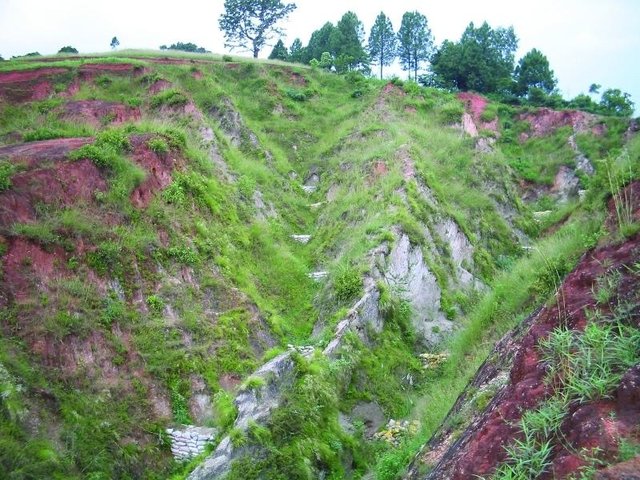
Gully plugging using check dams [เนปาล]
Small dam structures constructed across erosion gullies
- ผู้รวบรวม: Nicole Guedel
2. คำอธิบายของแนวทาง SLM
2.1 การอธิบายแบบสั้น ๆ ของแนวทาง
Supporting local initiatives and building local capacity for the rehabilitation of degraded communal land in the middle mountains of Nepal.
2.2 การอธิบายอย่างละเอียดของแนวทาง
การอธิบายอย่างละเอียดของแนวทาง:
Aims / objectives: The main aim of the People and Resource Dynamics Project's (PARDYP) land rehabilitation activities were to help watershed residents, local groups, and line agencies understand the key issues and to test options for the improved management of water, land, and forests in a participatory way. In Dhotra VDC (Kavrepalanchok district) a local youth club (Ekantabasti Youth Club) had been trying to rehabilitate a 2.5 ha area of degraded communal land since May 2004. The club approached PARDYP for technical assistance. The area had been degraded by overgrazing with two big gullies formed and small landslips along the gullies affecting a trail and the adjoining agricultural land. An unsuccessful attempt had been made to plant the area eight years previously. It had failed due to the difficulty of retaining soil moisture in the area's compacted red soils. A series of meetings were organised to plan future activities, to ensure community participation, and to share responsibilities among local users and PARDYP. The community was committed to rehabilitating the area and took the responsibility for planting, protection, and overall management of the planted species. PARDYP provided planting materials and technical help. A needs assessment with the local people identified the most useful tree species. They entrusted the selection of appropriate grass and hedgerow species to the project's expertise. Project staff arrange for planting materials and logistical support, and showed villagers how to make eyebrow pits, plant hedgerows, and plug gullies. About 450 villagers participated in the rehabilitation activities with women contributing more than half of the labour. They worked four hours a day for 16 mornings.
Methods: A five-women strong user committee was formed to manage and protect the planted species and a five-man strong task force was set up to maintain regular links and coordination between the user committee, the youth club, and the villagers. The coordination committee, with guidance from the youth club, was responsible for facilitating and coordinating all the second season rehabilitation work in 2005.
2.3 รูปภาพของแนวทาง
2.5 ประเทศ ภูมิภาค หรือสถานที่ตั้งที่ได้นำแนวทางไปใช้
ประเทศ:
เนปาล
ข้อมูลเฉพาะเพิ่มเติมของสถานที่ตั้ง:
Kavrepalanchowk/ Jhikhu khola watershed
Map
×2.6 วันที่เริ่มต้นและสิ้นสุดของแนวทาง
การสิ้นสุดลง (ถ้าแนวทางไม่ได้ใช้อีกต่อไป):
2005
2.7 ประเภทของแนวทาง
- ใช้โครงงานหรือแผนงานเป็นฐาน
2.8 เป้าหมายหรือวัตถุประสงค์หลักของแนวทาง
The Approach focused on SLM only
- To demonstrate appropriate technologies for rehabilitating degraded land and evaluating their effectiveness. - To provide training on soil and water conservation (SWC) technologies for effectively implementing the rehabilitation activities and to build the capacity of the local community to carry out the work. - To organise and mobilise a local community for implementing, protecting and managing the planted areas and the physical structures
The SLM Approach addressed the following problems: - Lack of awareness about low cost soil and water conservation technologies that address farmers' needs. - Weak institutional collaboration for developing and implementing technologies
2.9 เงื่อนไขที่เอื้ออำนวยหรือเป็นอุปสรรคต่อการนำเทคโนโลยีภายใต้แนวทางนี้ไปปฏิบัติใช้
การมีไว้ให้หรือการเข้าถึงแหล่งการเงินและบริการ
- เป็นอุปสรรค
Government incentives lacking
Treatment through the SLM Approach: Cost-effective technology demonstrated; planting materials and other logistic support provided
การจัดตั้งระดับองค์กร
- เป็นอุปสรรค
Weak institutional collaboration for technology development and demonstration
Treatment through the SLM Approach: Collaboration with local youth club; formation of user committee and task force
กรอบแนวทางในการดำเนินการด้านกฎหมาย (การถือครองที่ดิน สิทธิในการใช้ที่ดินและน้ำ)
- เป็นอุปสรรค
The existing land ownership, land use rights / water rights hindered a little the approach implementation The land is owned by the state and prior to starting the work there was a conflict over where the boundaries lay. Adjacent private landowners illegally claimed a part of the land but withdrew their claims before the rehabilitation work started. The existing land ownership and land use rights hindered the implementation of the approach at the beginning.
ความรู้เกี่ยวกับ SLM การเข้าถึงการสนับสนุนด้านเทคนิค
- เป็นอุปสรรค
Limited knowledge of appropriate SWC technologies and limited technical know-how to implement them
Treatment through the SLM Approach: On-site training and exchange visits organised to demonstration sites
3. การมีส่วนร่วมและบทบาทของผู้มีส่วนได้ส่วนเสียที่เกี่ยวข้อง
3.1 ผู้มีส่วนได้ส่วนเสียที่เกี่ยวข้องในแนวทางนี้และบทบาท
- ผู้ใช้ที่ดินระดับท้องถิ่นหรือชุมชนระดับท้องถิ่น
Planning, implementing SLM activities and protection. Men and women worked equally. About 450 villagers participated in the rehabilitation activities. Women's participation was a little higher, they provided 56% of the labour.
- ผู้เชี่ยวชาญ SLM หรือที่ปรึกษาการเกษตร
- องค์กรพัฒนาเอกชน
Technical and logistics support
- รัฐบาลแห่งชาติ (ผู้วางแผน ผู้ทำการตัดสินใจ)
ถ้ามีผู้มีส่วนได้ส่วนเสียหลายคนที่เกี่ยวข้องให้ระบุหน่วยงานตัวแทน:
Initiation and implementation by local youth club representing land users. Technical and logistics support by national specialists
3.2 การเกี่ยวข้องของผู้ใช้ที่ดินระดับท้องถิ่นหรือชุมชนระดับท้องถิ่นในช่วงต่างๆของแนวทาง
| ความเกี่ยวข้องของผู้ใช้ที่ดินระดับท้องถิ่นหรือชุมชนระดับท้องถิ่น | ระบุผู้ที่มีส่วนเกี่ยวข้องและอธิบายกิจกรรม | |
|---|---|---|
| การริเริ่มหรือการจูงใจ | ปฏิสัมพันธ์ | Local youth club approached PARDYP for technical help during a meeting. |
| การวางแผน | ปฏิสัมพันธ์ | Public meetings organised to share responsibilities. Land users took responsibility for land preparation, planting, protection, grazing control, and overall management of planted species. Men and women performed planned activities together. Construction of eyebrow pits done mostly by men. Filling o |
| การดำเนินการ | ระดมกำลังด้วยตนเอง | Self-mobilised group under leadership of youth club implemented the activities; technical guidance during implementing period provided by project |
| การติดตามตรวจสอบหรือการประเมินผล | ปฏิสัมพันธ์ | Survival of planted species, effect of eyebrow pits, performance of species and check dams were monitored/observed. Results shared in public meetings and reported to the project |
| Research | ไม่มี |
3.3 แผนผังแสดงขั้นตอนการทำงาน (ถ้ามี)
คำอธิบาย:
PARDP project donors and implementing partners: SDC: (Swiss Agency for Development and Cooperation); IDRC (Internat. Development Research Centre); ICIMOD
ผู้เขียน:
Dhakal Madhav
3.4 การตัดสินใจเลือกใช้เทคโนโลยี SLM
ระบุผู้ที่ทำการตัดสินใจเลือกเทคโนโลยีมากกว่าหนึ่งวิธีไปปฏิบัติใช้:
- ผู้เชี่ยวชาญ SLM เป็นผู้ตัดสินใจหลัก ที่ติดตามให้คำปรึกษากับผู้ใช้ที่ดิน
การอธิบาย:
A local youth club (Ekantabasti youth club) has initiated rehabilitation activities on the degraded communal land since May 2004. The youth club approached PARDYP for the technical assistance.
Decisions on the method of implementing the SLM Technology were made by mainly by land users supported by SLM specialists. Villagers took the responsibility for planting, protecting, and overall management of the planted species. PARDYP arranged planting materials and technical support
4. การสนับสนุนด้านเทคนิค การสร้างขีดความสามารถ และการจัดการด้านความรู้
4.1 การสร้างขีดความสามารถ / การอบรม
ได้มีการจัดอบรมให้แก่ผู้ใช้ที่ดินหรือผู้มีส่วนได้ส่วนเสียคนอื่น ๆ หรือไม่:
ใช่
ให้ระบุว่าใครเป็นผู้ได้รับการอบรม:
- ผู้ใช้ที่ดิน
รูปแบบการอบรม:
- ใช้พื้นที่ทำการสาธิต
หัวข้อที่พูด:
On-site training sessions were organised for establishing the eyebrow pits, contour hedgerows, gully treatments, and check dams and their maintenance.
4.2 การบริการให้คำแนะนำ
ผู้ใช้ที่ดินมีการเข้าถึงการรับบริการให้คำปรึกษาหรือไม่:
ใช่
ระบุว่ามีบริการให้คำปรึกษาหรือไม่:
- ไปเยี่ยมชมสถานที่
การอธิบาย/แสดงความคิดเห็น:
Name of method used for advisory service: Rehabilitation of degraded land thorough demonstration and training; Key elements: On site training, Demonstration, Exchange visits and public meetings; After implementing the technology, a number of exchange and interaction, audio visual presentation, and monitoring programmes were carried out as a scaling up strategy.
Advisory service is quite adequate to ensure the continuation of land conservation activities; Trained human resources can continue the activities.
4.3 การเสริมความแข็งแกร่งให้กับสถาบัน (การพัฒนาองค์กร)
สถาบันได้รับการจัดตั้งขึ้นมาหรือเสริมความแข็งแกร่งโดยแนวทางนี้หรือไม่:
- ใช่ ปานกลาง
ระบุระดับของสถาบันที่ได้รับการเสริมความแข็งแกร่งหรือจัดตั้งขึ้นมา:
- ท้องถิ่น
ระบุประเภทของการให้ความช่วยเหลือสนับสนุน:
- การสร้างขีดความสามารถ / การอบรม
ให้รายละเอียดเพิ่มเติม :
Technical training was provided to local youth club.
4.4 การติดตามตรวจสอบและประเมินผล
การติดตามตรวจสอบและประเมินผลเป็นส่วนหนึ่งของแนวทางหรือไม่:
ใช่
ความคิดเห็น:
bio-physical aspects were ad hoc monitored through observations; indicators: soil type and texture
technical aspects were regular monitored through measurements; indicators: performance of planted species and their survival rates
socio-cultural aspects were ad hoc monitored through observations; indicators: preferred tree species and closing the area for grazing
economic / production aspects were ad hoc monitored through observations; indicators: seed and grass production
no. of land users involved aspects were ad hoc monitored through observations; indicators: participation in maintaining planted species and structures
There were no changes in the Approach as a result of monitoring and evaluation: The users increased the size of the eyebrow pits and dug new pits and extended the hedgerow lines to fill in gaps; but the overall approach was not changed.
4.5 การวิจัย
การวิจัยเป็นส่วนหนึ่งของแนวทางหรือไม่:
ใช่
ระบุหัวข้อเรื่อง:
- เทคโนโลยี
ให้ข้อมูลเพิ่มเติมและให้ระบุผู้ทำการวิจัย:
Research was not a major focus of the approach although the performance and survival rates of planted species, and performance of eyebrow pits and connecting drainage trenches were regularly observed.
Research was carried out on-farm
5. การสนับสนุนด้านการเงินและวัสดุอุปกรณ์
5.1 ระบุงบประมาณประจำปีสำหรับแนวทาง SLM นี้
ถ้าหากว่างบประมาณประจำปีไม่เป็นที่ทราบแน่นอน ให้ระบุช่วงลงไป:
- < 2,000
แสดงความคิดเห็น (แหล่งของการระดมทุน ผู้บริจาคคนสำคัญ):
Approach costs were met by the following donors: international (SDC, IDRC, ICIMOD): 90.0%; local community / land user(s) (materials and tools for training): 10.0%
5.3 เงินสนับสนุนสำหรับปัจจัยนำเข้า (รวมถึงแรงงาน)
- การเกษตร
| ระบุปัจจัยนำเข้าที่ได้รับการสนับสนุน | เห็นด้วยระดับไหน | ระบุเงินสนับสนุน |
|---|---|---|
| เมล็ด | From projects own seed bank | |
| Seedlings | ได้รับการช่วยเหลือทางการเงินบางส่วน | Some locally arranged and some from forest departm |
ถ้าแรงงานโดยผู้ใช้ที่ดินเป็นปัจจัยนำเข้าที่มีอยู่มากมาย ระบุด้วยว่าเนื่องจาก:
- สมัครใจ
ความคิดเห็น:
Land users involvement was fully voluntary, they worked together in a cooperative spirit to improve their common degraded land.
5.4 เครดิต
มีการจัดหาเครดิตมาให้ภายใต้แนวทาง SLM หรือไม่:
ไม่ใช่
6. การวิเคราะห์ผลกระทบและการสรุป
6.1 ผลกระทบของแนวทาง
ช่วยให้ผู้ใช้ที่ดินนำเอาเทคโนโลยี SLMไปใช้และบำรุงรักษาสภาพไว้ได้หรือไม่:
- ไม่ใช่
- ใช่ เล็กน้อย
- ใช่ ปานกลาง
- ใช่ อย่างมาก
An organized land users' group was formed, and awareness on SLM increased.
ปรับปรุงประเด็นของการถือครองที่ดินหรือสิทธิในการใช้ ซึ่งขัดขวางการนำเทคโนโลยีไปใช้ให้ดีขึ้น:
- ไม่ใช่
- ใช่ เล็กน้อย
- ใช่ ปานกลาง
- ใช่ อย่างมาก
Project requested the users to solve the problem before rehabilitation work, users community and private land users solved the issue by measuring area of the community land. An authorized technician from the government office helped solving the issue.
Did other land users / projects adopt the Approach?
- ไม่ใช่
- ใช่ เล็กน้อย
- ใช่ ปานกลาง
- ใช่ อย่างมาก
The approach adopted during rehabilitation activities is quite standard and is taken by many other land management and community development projects.
6.2 แรงจูงใจหลักของผู้ใช้ที่ดินเพื่อที่จะนำ SLM ไปปฏิบัติใช้
- จิตสำนึกด้านสิ่งแวดล้อม
reduction of soil erosion
- การปรับปรุงด้านสุทรียภาพ
to maintain greenery.
6.3 ความยั่งยืนของกิจกรรมของแนวทาง
ผู้ใช้ที่ดินสามารถทำให้สิ่งต่างๆ ที่ได้ปฏิบัติใช้โดยแนวทางนี้ยั่งยืนได้หรือไม่ (โดยไม่มีการสนับสนุนจากภายนอก):
- ไม่แน่ใจ
ถ้าตอบว่าไม่หรือไม่แน่ใจ ให้ระบุและแสดงความคิดเห็น :
Land users planned to upscale the technology and its related approach to rehabilitate the degraded areas of their community forest but it hasn't happened yet.
6.4 จุดแข็งและข้อได้เปรียบของแนวทาง
| จุดแข็ง / ข้อได้เปรียบของแนวทางในทัศนคติของผู้ใช้ที่ดิน |
|---|
| Suitable technologies were shared and valuable knowledge given during the rehabilitation work (How to sustain/ enhance this strength: Continue this incorporating new ideas) |
| Community institution strengthened, and some money (US$ 17) raised by selling grasses and grass seed within two years of rehabilitation. Money used for social activities (How to sustain/ enhance this strength: As above) |
| จุดแข็ง / ข้อได้เปรียบของแนวทางในทัศนคติของผู้รวบรวมหรือวิทยากรหลัก |
|---|
| Site visits and focus group discussion meetings were effective for disseminating and scaling up the approach (How to sustain/ enhance this strength: Continue these initiatives on a regular basis to strengthen land users??? involvement in SLM activities) |
| Among total participants, women's participation was higher. User committee was made up of just women (How to sustain/ enhance this strength: Continue this) |
| The local youth club played a key role in rehabilitation activities - a key factor for sustainability and continuity (How to sustain/ enhance this strength: More local institutions should be identified and involved.) |
| This is a bottom-up approach with the rehabilitation activities purely demand driven. Farmers' priorities for tree species to be planted were identified in a participatory way (How to sustain/ enhance this strength: Continue by including new priorities) |
6.5 จุดอ่อน / ข้อเสียเปรียบของแนวทางและวิธีในการแก้ไข
| จุดอ่อน / ข้อเสียเปรียบในทัศนคติของผู้ใช้ที่ดิน | สามารถแก้ไขปัญหาได้อย่างไร |
|---|---|
| Research was not a main focus of the activity, and not enough options were explored. | Explore and test more options |
| จุดอ่อน / ข้อเสียเปรียบในทัศนคติของผู้รวบรวมหรือวิทยากรหลัก | สามารถแก้ไขปัญหาได้อย่างไร |
|---|---|
| Collaboration with government line agencies was lacking | Rehabilitation work should be carried out involving all main stakeholders |
7. การอ้างอิงและการเชื่อมต่อ
7.1 วิธีการหรือแหล่งข้อมูล
- ไปเยี่ยมชมภาคสนาม การสำรวจพื้นที่ภาคสนาม
- การสัมภาษณ์กับผู้ใช้ที่ดิน
7.2 การอ้างอิงถึงสิ่งตีพิมพ์
ชื่อเรื่อง ผู้เขียน ปี ISBN:
ICIMOD (2007) Good Practices in Watershed Management, Lessons Learned in the Mid Hills of Nepal. Kathmandu: ICIMOD
ช่องทางในการสืบค้น และราคา:
ICOMOD
ลิงก์และโมดูล
ขยายทั้งหมด ย่อทั้งหมดลิงก์

Gully plugging using check dams [เนปาล]
Small dam structures constructed across erosion gullies
- ผู้รวบรวม: Nicole Guedel
โมดูล
ไม่มีโมดูล


